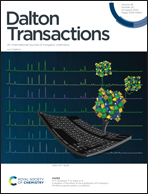Mono and dinuclear iridium(iii) complexes featuring bis-tridentate coordination and Schiff-base bridging ligands: the beneficial effect of a second metal ion on luminescence†
Abstract
The synthesis and photophysical properties of a set of iridium(III) complexes featuring tridentate N^N^O-coordinating ligands are described, of generic structure [Ir(N^C^N-dpyx)(N^N^O-Ln)]+ (n = 1 to 4) (dpyx = 1,3-dipyridyl-4,6-dimethylbenzene). The proligands HLn are Schiff bases synthesised by condensation of salicylaldehydes with N-methyl-hydrazinopyridines: they are able to coordinate to the Ir(III) via lateral pyridine-N and phenolate-O− atoms and a central hydrazone-N atom; the four examples differ in the substitution pattern within the phenolate ring. The bis-tridentate coordination is confirmed by X-ray diffraction. The complexes are phosphorescent in solution at ambient temperature, with higher quantum yields and longer lifetimes than those of structurally related bis-cyclometallated complexes with an N^N^C-coordinating ligand. Related proligands H2L5 and H2L6 have been prepared from 4,6-bis(1-methyl-hydrazino)pyrimidine. They feature a central pyrimidine and two N^N^O units. They are shown to bind as ditopic, bis-tridentate ligands with two iridium(III) ions, leading to unprecedented dinuclear complexes of the form [{Ir(N^C^N)}2(O^N^N–N^N^O-Ln)]2+ (n = 5, 6; N^C^N = dpyx or 1,3-dipyridyl-4,6-difluoro-benzene), with an intramolecular Ir⋯Ir distance of around 6 Å determined crystallographically. Mononuclear analogues [Ir(N^C^N-dpyx)(N^N^O-HLn)]+ have also been isolated. The dinuclear complexes display a well-defined and unusually intense lowest-energy absorption band in the visible region, around 480 nm. They emit much more efficiently than their mononuclear counterparts, even though the emission wavelengths are comparable. Their superior performance appears to be due to an enhancement in the radiative rate constant, affirming conclusions drawn from recent related studies of dinuclear Ir(III) and Pt(II) complexes with ditopic, pyrimidine-based cyclometallating ligands.



 Please wait while we load your content...
Please wait while we load your content...